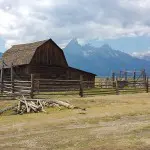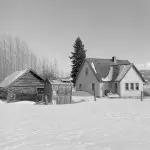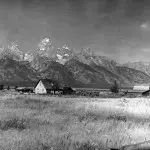John Moulton first arrived in Jackson Hole with his brother, Thomas Alma in 1907. They filed for adjacent claims and began work to clear 80 acres of land, construct a cabin, barn, corrals and related fencing. In 1916, he received the patent for his land. John was well known in the valley for his dairy business, and lived to be 103 years old; he is largely remembered, however for the “pink house” he built on Mormon Row. Many recognize the pink house, but few know the story behind the unusual hue chosen for the exterior. While John’s wife, Bartha was in the hospital, John wanted to do something special to commemorate her homecoming. He knew that she had wanted to repaint the house, and due to a small mix-up, chose the salmon pink color. When Bartha came home, she despised the color but so loved the sentiment behind it, that it was never changed.
John first met Bartha through his brother Alma’s wife Lucile. Bartha and Lucile were sisters, and when Lucile was due to have her first child on the Mormon Row ranch, Bartha traveled from Idaho to act as midwife. It was Bartha who was first interested in John, recognizing his skills as a successful homesteader. In 1917, they were married and Bartha moved to the ranch. Soon they were joined by four children in their tiny homestead cabin. It must have been a reasonably comfortable life, as they didn’t replace the little cabin until 1934 when they constructed the wooden frame pink house that still stands today. Life on Mormon Row meant hard work, but it was good work. As much as the residents worked, they found plenty of time for fun and enjoyment of each other’s company. They often held dances in their church, or parties in each other’s houses. Despite living on a connected road, they all brought enough food so that these events lasted well over a day.
In the beginning, the families dry farmed, relying solely on the rains that fell each summer. For domestic purposes, water was hauled up from the Gros Ventre River. When Joe Pfeiffer settled on lands north of Mormon Row on Antelope Flats in 1910, he provided the important service of digging wells. Pfeiffer dug wells for the residents of Mormon Row, but after digging out 120 feet of his own well, gave up when finding no water. The Pfeiffer homestead later burned in the Antelope Flats fire in 1994.
In the later 1920s, John and Bartha saw a need in the valley to provide the growing dude ranches with dairy supplies. Fresh foods were a rarity on the early dude ranches, and the ability to purchase locally-sourced supplies meant that costs could be kept low. This also benefitted the Moultons, who were in need of cash, especially to pay for hay for their cows and horses during the rough winters. Their dairy business was successful, and they provided for customers as far north as Yellowstone. Another important source of income on the ranch was Bartha’s chickens. Fresh eggs were considered as valuable as money, and she used her 60+ chickens to buy the supplies she couldn’t readily procure on the ranch.
In 1945, the Moultons built a bunkhouse on the ranch as a temporary home for their son and daughter-in-law, Reed and Shirley Moulton; it still stands today. The small cabin was only used for a season, as Reed and Shirley moved to the adjacent Thomas Murphy/Joe Heninger property just to the north. Their cabin was then used as a bunkhouse, and the Moultons later hosted paying summer guests who used it for overnight or weeks-long stays. The granary, shower house and pump house still remain on the property. Around this time life along Mormon Row was changing greatly due to the recent 1943 creation of the Jackson Hole National Monument. Those living on Mormon Row were seeing their future prospects dwindling as they were now surrounded by protected federal lands. Neighbors and family members began selling their property to the Snake River Land Company, moving into the town of Jackson, or away from the valley completely.
By 1950 when Grand Teton National Park was expanded to include the Jackson Hole National Monument lands, even more sold to the National Park Service. Mormon Row was now quiet, where it had been bright and busy just a decade before. Due to the 1927 Kelly flood that caused Mud Springs to begin producing water, the farm lands around Mormon Row now also had the ability to irrigate their fields. Families living here did not face the same challenges of dry farming that the rest of the valley did, their homesteads were successful and originally spared from the Snake River Land Company’s purchasing schedule. However, fear that they would lose access to the public lands for grazing, their 160 acres felt too small to survive on. Many worried how their lives would change with federally regulated lands on their borders.
In 1953, at the age of 66, John Moulton sold his property to Grand Teton National Park with a life lease. Now without taxes or a mortgage, some of the financial pressure was lifted. He was allowed to continue to live and work on his land, under certain rules. Upon his death, the National Park Service would acquire the land and the family would be required to leave the property. Under life leases, most families remained for a handful of years, but John would keep his homestead for another 37 years. His sons continued to ranch the land until the late 1970s and John retired in the town of Jackson. It wouldn’t be until 1990 when John died at 103 that his land would finally change hands. In 1991 his family made the last trip out to the pink house to gather their belongings and leave the Row for the last time. They were not the last to leave, however, as John’s brother Alma‘s home still survives on one acre of private land. John’s grand-nephew continues to live on the acre, the fourth generation of Moultons to live in the shadow of the Tetons.
TIMELINE
1907: John first arrives in Jackson Hole with his brother, Thomas Alma. Both brothers settle on adjacent parcels and help each other with the necessary work to prove up on their land.
1910: Joe Pfeiffer arrives on Mormon Row and assists the residents with digging wells to supply the houses with water.
1912: Alma brings his wife, Lucile into the valley. Her sister, Bartha Blanchard arrives to act as midwife for the birth of Lucile’s baby.
1916: John and Alma receive the patents for their land.
1917: John marries Bartha Blanchard, and the two live next door to Alma and Lucile on Mormon Row.
1920-29: John and Bartha go into the dairy business, supplying the valley dude ranches with fresh dairy products. Their customers reach as far north as Yellowstone National Park. To supplement the dairy, Bartha kept 60 chickens to lay fresh eggs. The eggs are highly valued, and used as money.
1934: John and Bartha construct a new wooden frame house, with two stories and a basement. Today it is known as the “pink house” due to its unique exterior color.
1945: The Moultons construct a small cabin for their son and daughter-in-law, Reed and Shirley. The cabin is only used for a season, and is later converted to use as a bunkhouse for paying summer guests.
1953: John Moulton sells his property to Grand Teton National Park, keeping a life lease. He and his son, Reed, who lives next door on the Thomas Murphy/Joe Heninger homestead continue to run the ranching and dairy business.
1990: At 103 years old, John Moulton dies in the town of Jackson and his property is acquired by Grand Teton National Park. The bunkhouse, shower house, outhouse, pump house, barn, corrals and pink house still exist.
Text by Samantha Ford, Director of Historical Research and Outreach





